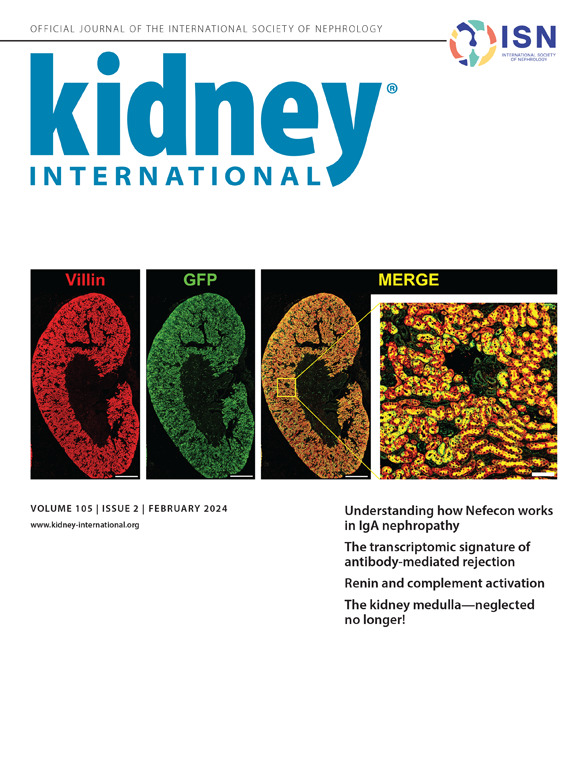1型和2型糖尿病患者蛋白尿与肾小球结构关系的异质性
IF 12.6
1区 医学
Q1 UROLOGY & NEPHROLOGY
引用次数: 0
摘要
肾脏结构-功能关系研究对于了解糖尿病肾病(DKD)的演变至关重要。然而,大多数此类研究是在1型糖尿病患者中进行的,糖尿病肾小球病变与白蛋白排泄率(AER)密切相关。在这里,我们比较了1型和2型糖尿病中DKD的结构-功能关系。方法为了更好地了解2型糖尿病患者DKD的演变,研究人员分析了133名2型糖尿病志愿者和161名AER匹配的1型糖尿病志愿者的肾小球结构与蛋白尿的关系,并与95名活体肾脏活检作为对照。结果1型糖尿病患者与2型糖尿病患者相比,DKD肾小球病变的形态测量更先进,且与AER的关系更强。基于从1型糖尿病研究参与者的数据中得出的结构-功能关系模型的距离的k -均值聚类分析得出两个簇:74%的2型糖尿病参与者在簇1中,其中也包括大多数1型糖尿病参与者,而26%的2型糖尿病参与者在簇2中,其AER高于基于该模型的DKD肾小球病变预测。在2型糖尿病患者中,尽管在第2类患者中存在过量的AER,但两类患者的DKD肾小球病变和足细胞结构参数相似。然而,根据AER进行调整后,在9到10年的随访中,第1类2型糖尿病患者的DKD病变更严重,肾小球滤过率下降率比第2类患者高约4倍。结论:肾小球结构-功能关系在2型糖尿病患者中存在异质性,这种异质性与肾小球滤过率随时间的降低有关。我们的调查需要进一步的研究来更好地理解这种异质性的因素。本文章由计算机程序翻译,如有差异,请以英文原文为准。
Heterogeneity in the relationships between albuminuria and glomerular structure in type 1 and type 2 diabetes.
INTRODUCTION
Kidney structural-functional relationship studies have been critical in understanding diabetic kidney disease (DKD) evolution. However, most such studies were performed in persons with type 1 diabetes, where diabetic glomerular lesions are strongly associated with albumin excretion rate (AER). Here, we compare DKD structural-functional relationships in type 1 and type 2 diabetes.
METHODS
To better understand the evolution of DKD in type 2 diabetes, analyses of glomerular structure/albuminuria relationships were performed in 133 research volunteers with type 2 and 161 with type 1 diabetes matched for AER compared to 95 living donor kidney biopsies as controls.
RESULTS
Morphometric measures of DKD glomerular lesions were more advanced and showed stronger relationships with AER in persons with type 1 vs type 2 diabetes. K-means cluster analysis based on distance from a structural-functional relationship model derived from data of research participants with type 1 diabetes yielded two clusters: 74% of participants with type 2 diabetes were in Cluster 1, which also included most participants with type 1 diabetes, while 26% of participants with type 2 diabetes were in Cluster 2 and showed greater AER than predicted by their DKD glomerular lesions based on the model. Among those with type 2 diabetes, despite excessive AER in Cluster 2, DKD glomerular lesions and podocyte structural parameters were similar between the two clusters. However, adjusted for AER, individuals with type 2 diabetes in Cluster 1 had more severe DKD lesions and approximately four-fold greater rates of glomerular filtration rate decline over nine to ten years follow up than those in Cluster 2.
CONCLUSIONS
Kidney structural-functional relationships are heterogeneous in individuals with type 2 diabetes, and this heterogeneity is linked to glomerular filtration rate loss over time. Our investigation calls for further studies to better understand factors involved in this heterogeneity.
求助全文
通过发布文献求助,成功后即可免费获取论文全文。
去求助
来源期刊

Kidney international
医学-泌尿学与肾脏学
CiteScore
23.30
自引率
3.10%
发文量
490
审稿时长
3-6 weeks
期刊介绍:
Kidney International (KI), the official journal of the International Society of Nephrology, is led by Dr. Pierre Ronco (Paris, France) and stands as one of nephrology's most cited and esteemed publications worldwide.
KI provides exceptional benefits for both readers and authors, featuring highly cited original articles, focused reviews, cutting-edge imaging techniques, and lively discussions on controversial topics.
The journal is dedicated to kidney research, serving researchers, clinical investigators, and practicing nephrologists.
 求助内容:
求助内容: 应助结果提醒方式:
应助结果提醒方式:


